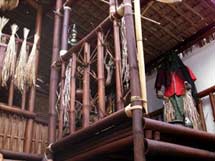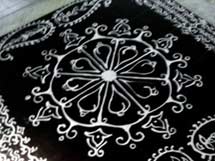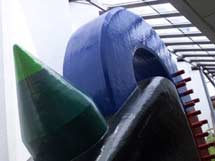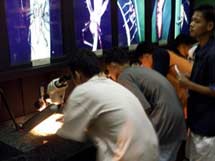RICEWORLD
By: Susie Borerro
Welcome to the World of Rice!
Have you ever wondered …
… Where rice comes from?
… How many people in the
world eat rice?
… Where rice is planted in
other parts of the world?
… How versatile the rice
plant is ?
… How many kinds of rice
there are ?
The answers to these questions
and many more will be revealed
as you embark upon your journey
through Riceworld.
Riceworld is a science museum.
It is only museum and learning
center in the world that is
dedicated to rice. And no
wonder! Riceworld was established
by the International Rice
Research Institute (IRRI)
in 1994 in Los Baños,
Laguna. (IRRI is an international
rice center established to
help farmers in developing
countries grow more rice on
limited land with less water,
less labor, and less chemical
inputs, and to do so without
harming the environment.)

In
pagdiwata, the baylana
communicates with supernatural
beings to ask them to
cure illness of any
sort. |
Riceworld was designed with
a careful mixture of touch,
feelings, and thought. The
exhibits here present opportunities
that encourage curiosity,
questioning, discussion, and
exploration. In this way,
visitors, both children and
adults, can share in the excitement
of the learning process as
they explore the world of
rice.
The museum is divided into
12 sections. The display area
contains a large collection
of rice artifacts, farming
tools, farm machineries, rice
products and by-products,
illustrations of rice ecosystems,
samples of rice seeds from
different parts of the world,
replicas of rice granaries,
farmers’ clothing, insects
that are friendly and harmful
to rice, photographs of women
rice farmers, representations
of rice biotechnology. There
are also sections in the museum,
which have computer terminals
and “hands-on” models to enhance
the learning experience.

Alpana
is rice calligraphy
that dates back to the
time rice was domesticated
as a crop in eastern
India. |
Interesting exhibits include
carbonized rice grains dating
900-500 B.C., which were discovered
in Ban Na Di site in Thailand;
farming tools, such as punuptop
hi luta (tamper), patun galeqqun
(mallet), and puhiq (pounding
stone), which were used to
build and shape the world
famous Ifugao Rice Terraces;
and samples of rice seeds,
including the high-yielding
rice variety IR8.

The momi sculpture shows
the vitality of wild
rice at germination
stage. |
The alpana and momi are among
the curious exhibits in the
museum. Alpana is a traditional
art of Bengal and Orissa in
East India. It uses rice paste
to depict favorable events,
such as the rice harvest and
other Hindu festivals. The
alpana in the museum was made
by Dr. Savitri Singh. The
momi is a wooden sculpture
of wild rice at germination.
Created by Japanese sculptor
Mitsuaki Tanabe, the sculpture
shows the rice seed that is
partially out of the ground.
There is also an intriguing
depiction of the pagdiwata
of the Tagbanwas, a tribal
group living in central Palawan
island. Pagdiwata is a healing
ritual performed by a baylana,
a priestess.

In
the Bug Room, young
visitors look into the
minute world of insects
inhabiting the rice
plant.ty of wild rice
at germination stage. |
The Bug Room provides an
opportunity to investigate
the relationships that link
insects, both friendly and
harmful, to rice. This section
is equipped with microscopes,
not the sophisticated laboratory
models but ones that can be
used by kids. Slides of insects
are mounted on large slabs
that make them easy to position
under the lens. The images
are bright and easy to see.

Visitors
learn about rice biotechnology. |
The Rice Biotech Section
gives a glimpse of the complexities
involved inenvironmental decision-making
and genetic engineering. It
helps visitors understand
how transgenic plants, such
as rice, impact the future
of rice-eating people and
their environment.
Riceworld is also distinctive
because it is also a virtual
museum. It can be viewed at
www.riceworld.org. The site
was launched in September
1998. In its first year, more
than 24,000 visitors have
taken a virtual tour of the
museum.
Science museums have gone
a long way from its old concept
of display cases. Today, science
museums preserve heritages
by informing, training, and
even teaching visitors through
the experiential process.
In this sense, Riceworld fits
the description of a modern
science museum.